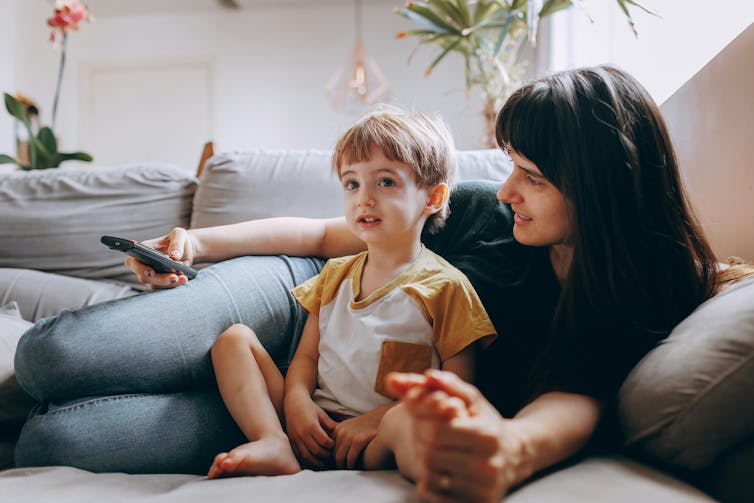A of the hit kids show Bluey will premiere on April 14. The episode will run for 28 minutes, which is four times the usual length of a Bluey episode. My kids are excited. In fact, I am too. As a parenting researcher and a mother I am a big Bluey fan.
Author
Divna Haslam
Senior Research Fellow, Queensland University of Technology
If you’re feeling guilty about letting your children watch yet another episode of Bluey, you shouldn’t. Bluey is a valuable show for kids and families, promoting a variety of positive messages.
Before we get to these, an important caveat. Parents get lots of messages about limiting screen time. Excess screen time is linked with poor outcomes including lower levels of and poorer for children.
So following the on screen time is important (this includes no screen time for children under two). I’m not endorsing unlimited Bluey, but a couple of 7-minute episodes, and even the new 28-minute episode, fit within recommended guidelines.
Why is Bluey good for families?
First, it models present, calm, engaged parents. Children benefit from who show affection, set consistent boundaries, and use assertive, non-violent forms of discipline. It’s particularly nice to see Bandit as a hands-on dad, even if mum Chilli seems to carry most of the .
Second, it normalises the realities of parenting we all face. The show depicts the joys of parenting but also the challenges. For example, in the episode we see mum saying she just needs 20 minutes by herself. Every parent can relate to needing a break. And even better, she actually takes the time. Looking after ourselves . Kids benefit when their parents’ own needs are met.
Third, the show tackles important issues such as and . This provides a context for parents and general viewers to talk about these topics. You’d be surprised how many non-parents have watched Bluey.
Finally, it pushes gender norms. Those unfamiliar with the show often assume the main character is a boy, and are surprised to learn that both Bluey and Bingo are girls. A children’s show with two female protagonists that’s popular globally with children of all genders is a big step forward for gender equality.
5 tips to get the most out of watching Bluey
1. Watch it with your kids
I don’t mean catching up on work emails while it’s on in the background. I mean actively watching it with your kids. While it’s tempting to use your children’s screen time to catch up on tasks, research has shown co-viewing high-quality shows is linked with and may mitigate some of the negative effects of screen time.
2. Talk about the show
Every episode has a multitude of conversation starters. Talk to your children about what’s happening during the episode. Ask why characters are making the decisions they’re making. Discuss how different characters might be feeling and why.
suggests talking with children about shows and books can help develop children’s empathy and emotional understanding. It also helps children see situations from other people’s perspectives, which is an important life skill.

3. Use it as a springboard for imaginative play
Play is important for children. It executive function (the ability to plan, focus and juggle multiple tasks) and prosocial behaviours such as sharing, turn taking, and showing kindness and empathy.
You are not limited to the games Bluey and Bingo love like “shadowland” (where children can only walk on shadows) and “restuarants” (where children pretend to run a pizza shop), but you can start with these if this style of play is new for your family. The best types of imaginative play are child-led, so encourage your child to determine the rules of the game. Start by asking “what shall we pretend today?”
4. Reflect on your own parenting
Chilli and Bandit are good models of positive parents. They use parenting strategies such as calmly responding to misbehaviour, giving clear instructions and showing affection. But they’re not perfect, and neither are we. They get tired and they make mistakes but most importantly they learn from them and try to improve.
This is a key lesson for us all. No parent is perfect all the time. What matters is doing our best, looking after ourselves and getting support when needed.
5. Highlight behaviour you want to see
Bluey and Bingo are generally good role models for kids. To encourage similar behaviour in your children, comment on positive things Bluey and Bingo do, noting what you admire about their actions (for example, “wasn’t that great how Bingo waited for Bandit to finish talking?”). Then look out for opportunities to when you notice them behaving well in real life. Praise works best when you’re specific about what you like and are being genuine.
A final word
While watching an episode or two of Bluey should be guilt-free, it’s important to engage in variety of physical and intellectual activities with children.
If you’re going to watch Bluey or another programme with your kids, it’s especially important this doesn’t come at the expense of reading with them, which is enormously for children. comparing reading with children and co-viewing TV shows shows reading is associated with much richer language interactions between parents and children, which may improve language development.
For bonus points, add some Bluey books into bedtime reading.
![]()
Divna Haslam has received funding from various granting bodies and the Australian government for parenting and family-related research. She is a contributing author to the Triple P Positive Parenting Program and a member of the Parenting and Family Research Alliance. She has no affiliation with the Bluey program.








